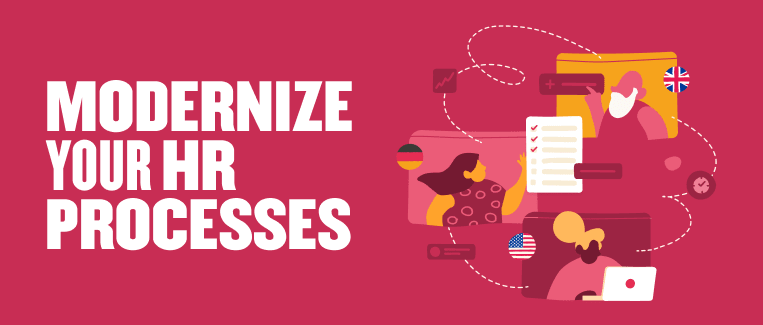In today’s ever-changing climate, agility and flexibility are key for confronting the changes in the market and economy that may eventually directly impact our own companies. When change is the only constant, implementing a solid HRIS (human resource information system) is more important than ever before to ensure that you’re ready for the challenges that lie ahead. Our recent webinar hosted by HiBob Senior Implementation Manager Dessie Nedyalkova, “Modernizing HR processes for fast-growing companies,” features three HR specialists:
- Ben Keefe, Senior Manager, People Operations at HiMama
- Camden Louthan, Human Resources Generalist at Kaléo
- Rukkini Sen, People Operations Specialist, Omnipresent
The panelists discussed how they recently started using Bob to help with their current challenges:
- Automating processes for onboarding and offboarding as volume increases
- Building and fostering company culture and values
- Implementing a tool that keeps processes consistent for all people
All three HR specialists share how putting Bob’s features into practice helped them as their companies continue to evolve and remain flexible.
HR automation means more productivity
Although sending out birthday or work anniversary messages may not seem time-consuming, time spent on these tasks does add up. Automating reminders to complete smaller tasks is helpful, but automating onboarding tasks is key for managing a complex and growing workforce.
Creating an automated onboarding process
Bob’s Task Lists feature—one of the tools the panelists use in their daily operations—lets users automate onboarding procedures by creating a customized new hire creation flow based on hire date.
HR teams can set up task lists to send out documents for signatures, assign time-off policies and benefits, and begin the journey of onboarding for specific positions.
From there, managers will know when to set up an orientation program and when IT members should provide equipment for the new person or grant access to other systems.
Organizations can create similar task lists to ensure the completion of all offboarding procedures when people leave the company. HR automation doesn’t stop there. Companies can also use this for time off and reporting processes and even integrate these features with other programs.
More time to think about vision
All that free time means that HR leaders can turn their focus to the larger picture. That’s more time to think strategically about the structures they have in place rather than the dozens of small things that previously occupied their to-do lists.
Automation also helps HR personnel find and relay answers to questions about analytics, key performance indicators (KPIs), and reports in seconds or minutes rather than hours or days.
“I think it’s freed us up to actually be answering those important questions for our leaders and actually be the advisors to the business that we aspire to be,” says Ben.
Build a stronger culture
As some people return to working in the office and many work remotely, it can be a challenge to grow and maintain a connection between co-workers who rarely—if ever—see each other in person.
The HR team has the responsibility to help nudge people in the right direction organically. Here’s where an HRIS and its tools can be extremely useful. For example, breaking the ice can be difficult for new team members in a traditional, in-office setting. It’s even harder in remote and hybrid work environments. An HRIS toolkit can help bring back a sense of familiarity and mirror the in-office employee experience.
Encourage engagement between team members
Camden expressed how much she likes Bob’s personal touch. Her company uses the system for introductions so that people can share more information about themselves and upload headshots to put faces to the names behind the screen.
“We’ve also faced the question of keeping the culture strong and making sure that we have that warmth, that level of personalization, with each person that comes through the door,” says Rukkini. “We really look for that characteristic in all the tools that we work with … One of the things that I like about HiBob is the Clubs feature. I think that’s a really nice way of bringing people together, regardless of where they are from.”
The Clubs feature is just what it sounds like, allowing people to start discussions and connect with other team members who have similar hobbies and interests. Organizations can set up different clubs according to people’s interests, whether for yoga, skiing, music, or knitting.
Ultimately, Clubs lead to stronger trust between team members and allow people to talk to others with whom they may not have spoken before. HR teams can also use analytics to break down Clubs engagement by age, nationality, department, and more.
Create consistency for everyone
The world of work has gone through a revolution, and things aren’t going back to how they were any time soon. While more people than ever are working remotely full-time, HR teams are also managing people who work from other countries.
It’s important to create a consistent, quality experience for everyone so people don’t feel like guests in their own workspace. This involves creating a personalized and tailored experience for each person.
A personalized experience can look like acknowledging the differences between countries, such as holidays, laws, compliance, and terminology. Also, it can be simply making sure people have access to the systems they need upon onboarding.
Recommended For Further Reading
Quick tips for evaluating an HRIS
Every company’s needs are unique. When choosing an HRIS, leaders should contemplate what is most important for their company to determine which system will deliver on and exceed expectations.
Consider the following when analyzing an HRIS system:
- Customizability
- Support and enhancement of current processes
- Internal resources to deploy, maintain, and optimize the system
- Support of the full team member lifecycle
- Integration with other systems
- Security
A good HRIS is flexible and able to withstand the changing tides of the current models of work.
Automating processes to focus on your people
Companies of all sizes and varieties are facing a constant evolution of work where agility and flexibility are key. It’s up to HR professionals to find the best ways to support their people through it all.
The right HR tech can help companies boost productivity and automate clear and consistent processes, from onboarding and offboarding to performance reviews and KPI tracking. HR automation gives HR time back to work on maintaining clear communication and consistency and help their people to feel safe and supported even during times of uncertainty and change.
This article is based on the presentation “Modernizing HR processes for fast-growing companies.” Watch the full webinar to learn how scaling companies can also grow their HR processes.

From Shelby Blitz
Shelby is the Director of Content at HiBob. She's passionate about the written word and storytelling. In a past life, she was a music journalist. When she's not writing and editing you can find her baking sweet treats in the kitchen.

